The Beauty of Wabi Sabi as the Spirit of Life of the Oldman in Japanese Fairytale
on
SAKURA VOL. 5. No. 1, Februari 2023
DOI: http://doi.org/10.24843/JS.2023.v05.i01.p11
P-ISSN: 2623-1328
E-ISSN:2623-0151
The Beauty of Wabi Sabi as the Spirit of Life of the Oldman in Japanese Fairytale
Isnin Ainie1, Cahyaningsih Pujimahanani2, Syifa Aulia Mareta3
-
1,2,3University of Dr. Soetomo, Surabaya, Indonesia
isnin.ainie@unitomo.co.id1; cahyaningsih.pujimahanani@unitomo.co.id3;
Abstract
Wabi sabi is one of Philosophy in Japan. It’s about appreciation to the beauty of imperfection. Wabi sabi can be found in so many aspects in Japanese people’s life such as chanoyu, ikebana, haiku, or fairytale of Japanese children. This article aims to know how the oldman gets the spirit of life by wabi sabi to cheer his life. Hanasaka Jiisan is used in this research as a source of data. The result is the beauty of wabi sabi is appeared by the oldman’ house, the falling leaves, the dead trees, and the falling flowers. Furthermore, wabi sabi as the spirit of life can be found in the old man who lives with his wife, the old man who takes care of a dog, the old man who takes the ash of mortar home, and the old man who throws ash all over the dead trees and it makes the lord of local castle so happy.
Keywords: Hanasaka Jiisan; simplicity of life; spirit of life; wabi sabi
Abstrak
Wabi sabi merupakan salah satu filosofi Jepang yang mengapresiakan keindahan dalam ketidaksempurnaan. Wabi sabi dapat dijumpai di berbagai aspek hidup orang Jepang seperti chanoyu, ikebana, haiku, atau dongeng anak-anak Jepang. Artikel ini bertujuan untuk mengetahui bagaimana seorang kakek mendapatkan semangat hidup melalui wabi sabi. Dongeng Hanasaka Jiisan merupakan sumber data artikel ini. Hasil yang diperoleh adalah keindahan wabi sabi tampak dari wajah rumah Kakek, daun-daun yang berguguran, pohon-pohon yang mati, dan bunga sakura yang berjatuhan. Selanjutnya, wabi sabi sebagai semangat hidup dapat diketahui dari sang Kakek yang hidup bersama istrinya, sang kakek yang merawat seekora anjing, sang kakek yang membawa pulang abu lesung, dan sang kakek yang melempar abu ke pepohonan yang telah mati dan membuat penguasa kastil bahagia.
Kata kunci: Hanasaka Jiisan; kesederhanaan hidup; semangat hidup; wabi sabi
Wabi sabi (written as 侘寂 or 侘び寂び ) consist of two separate words reflected aesthetic value, based on the perspective of literature, culture and religion. Finding beauty in simplicity, as well as a spiritual depth and tranquility in distancing oneself from the physical world, is what wabi is all about. Sabi is more concerned with the passage of time,
with the way that all things grow and decay and how ageing alters the visual nature of those things (Kempton, 2019: 30).
The feeling of remote isolation that comes with living in nature and the paradoxical beauty of imperfection (like a broken cup fixed with gold through kintsugi) is the original meaning of wabi. Sabi, depending on the context, can mean “withered,” “lean,” or “cooled” but more often refers to the beauty of aging – like the changing hue of wood, the comeliness of rust, the delicate droop and drying of roses in the sun (Longhurst, 2018: 61; Adek et al., 2020; Yurt & Basarir, 2020).
In historical meaning, wabi means the solitude of living in nature; and languishing. But in current meaning, It means simple rusticity; subdued beauty; freshness; tranquility; peculiarities or blemishes that are delightful. Sabi in historical meaning are wizened; wilted; rusted, and in current meaning are beauty and calm in what is mature or aged; pleasure felt when appreciating the imperfect (Suzuki, 2020: 33).
Wabi sabi is a concept in Japanese society that portrays the floating, changing, and imperfect beauty of nature all around us. Instead of looking for perfect beauty, we should look for it in things that are flawed, incomplete. This is why Japanese people value imperfection so much, for example, falling in love with an irregular or cracked teacup. only imperfect, incomplete, and ephemeral things can truly be beautiful because only those things truly resemble nature (Garcia and Miralles, 2016: 191). The key point is that there are some things over which we have no control, such as the passage of time and the ephemeral nature of the world around us. Wabi sabi teaches us to appreciate the beauty of imperfection as an opportunity to grow (Garcia and Miralles, 2016: 193).
Wabi-Sabi is often associated with a sense of peace, together with the natural development of life. Maintaining that life and the understanding that things are impermanent, enables us to love the beauty and sadness of it (Mori, 2019: 14).
Some principles to understand and feel wabi sabi as a way of life: 1) proceeding to use old objects but caring for them as if they were old friends, 2) learning to say 'no' to social or commercial opportunities that may not be what they appear to be, 3) avoiding getting frustrated by life’s imperfection, 4) taking things as they are, 5) Living in tune with nature, accommodating twist in fate and making the best out of change in a life which you are in harmony with yourself and with all that surrounds you, including your
friends and family, 6) practicing some form of art that allows you to adhere to the wabi sabi aesthetic principles (Suzuki, 2020: 24-25).
So many Japanese fairytales describe about wabi sabi in their story. One of is Hanasaka Ojiisan. It tells about the old man and his wife who lovingly cherish the lost dog. But the dog died because it was killed the greedy old man.
Wabi sabi teaches us to accept who we are and what we have now, no more, no less, and to love ourselves exactly as we are. The wabi-sabi philosophy inspires people to accept simplicity wholeheartedly and appreciate what we already have. (Kempton, 2018:38). Through Hanasaka Jiisan, we know the beauty of wabi sabi that can grow the spirit of someone’s life.
Descriptive qualitative design was applied in conducting this research. It is stated by Moleong that descriptive qualitative research is research which collects data in the form of words, images, and not numbers (Moleong, 1997:6). Descriptive method is used to analyze the spirit life of wabi sabi in Japanese Fairy tale Hanasaka Jiisan. Hanasaka Jiisan downloaded by http://www/keishindo.co.jp with pdf format is the main resource, meanwhile https://youtu.be/XxHuXhyaU78 is the second resource. The steps that author takes to collect data are 1) reading data sources in Japanese Fairytale Hanasaka Jiisan, 2) literalizing how to read Japanese letters into alphabet letters, 3) translating into English, 4) categorizing data based on theory of wabi sabi by Suzuki (2020). Then, the authors analyzes the data in the following way: 1) Authors display the analyzed data, 2) describing the data is in the form of narrative snippet of the story, 3) interpreting the data, and 4) making conclusions.
This research uses Suzuki's (2020) theory related to Wabi Sabi.
Some researches about wabi sabi are 1) research by Devi, et.al (2021) “The Reflection of Wabi Sabi in the Novel Joseito by Dazai Osamu” and the result find that
Dazai is willing to accept the contradictions in Japanese society by understanding the meaning of wabi sabi. He learns to appreciate, accept what it is, and be grateful for the contradictions in society which can establish harmony in a beautifully ordered life; 2) reseach by Endah Muthmainah (2021) “The Concept of Wabi Sabi on Nakahara Chuuya’s Poetry”. The research shows that there six concepts of wabi sabi on Poetry: kanashiku, shitsui, sabu, samu, sabishiki (futanoshiki), irosokuku no sekai, mazushiku, and mazushisa wo yutaka no nashi; 3) Jutta Trevinarus (2010) “The Value of Imperfection: The Wabi Sabi Principle in Aesthetic and Learning”. It shows value of wabi sabi in learning design is recognizing the importance of imperfection, mistakes, problems, disagreement, the incomplete for engaged learning, relinquishing our notions of perfection, acknowledging that learners learn differently. Shortly, the diverse learners is needed in today's economy.
A fairy tale entitled Hanasaka Jiisan is a simple and light children's fairy tale. Nevertheless, it is found out that there is a concept of the beauty of wabi sabi as the spirit of Grandpa's life, as the main character in the story.
The old house occupied by a pair of kind-hearted grandparents is a picture of wabi. Wabi is a picture of the beauty of simplicity. Suzuki (2020:33) defines wabi with a more modern meaning as rustic simplicity. In the story of Hanasaka jiisan, it is told that an old man lives with his wife.
昔むかしあるところに、正直者のおじいさんとおばあさんがくらしていました。
Mukashi mukashi aru tokoroni, shoujikisha no ojiisan to obaasan ga kurashite imashita.
Once upon a time, there lived an honest old man and his wife.
The word くらしていましたkurashite imasu (to live), shows that the grandparents live together in one place. In the story it is not explained in detail where the grandparents live, but the portrayal of a kind-hearted grandfather figure (shoujikisha no ojiisan) can describe that grandfather is living peacefully with his wife somewhere in a certain place. That statement is supported by the story of Hanasaka Jiisan in the following video
Picture 1
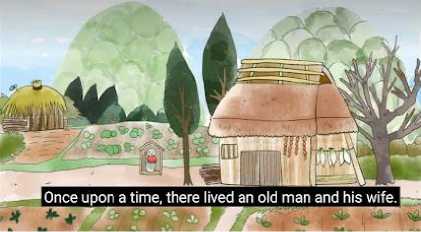
The beauty of Rustic Simplicity
The picture above shows the grandpa's house standing alone in a quiet village surrounded by vegetable gardens and trees. Next to the house, there is only a Buddha statue adding to the impression of simplicity of natural beauty. This is in accordance with the wabi portrayal of the beauty coming out from simplicity.
Furthermore, the beauty of sabi can be seen from the falling leaves in the video portraying the grandfather's sadness due to the death of his dog because of being killed by his neighbor.
怒った意地悪じいさんは犬を殺してしまいました。おじいさんとおばあさんは それを知ると大変悲しみにくれ、庭の隅に墓を作り…
Okotta ijiwaru Jiisan wa inu wo sashite shimaimashita. Ojiisan to obaasan wa sore wo shiruto taihen kanashimi ni kure, niwa no sumi ni haka wo tsukuri…
'That angry cunning grandpa killed the dog. Knowing this, the kind-hearted grandparents felt great sadness, they made a grave for the dog at the end of the yard…'
Picture 2
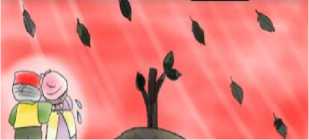
the beauty of fallen leaves
The shadow of the black leaves falling in the video describes the sabi according to Kempton (2019: 30), ‘passage of time, with the way that all things grow and decay and how ageing alters the visual nature of those things’. The togetherness of grandfather and dog who had lived together and had passed brings memories that live and grow in grandfather's mind.
The beauty of wabi sabi is then seen when grandfather passes by a withered tree carrying mortar ashes.
…ふいに風が吹き、灰が枯れ木にかかったかと思うと…
…Fui ni kaze wo fuki, hae ga kareki ni kakattaka to omouto...
‘… The wind blows, the ashes from the mortar stick to the withered tree…’
The withered tree (kareki) is a description of Longhurst's sabi, (2018: 61) that is “withered” refering to the beauty of aging. Withered tree describes a tree that has gone through a phase of growing, blooming, until finally aging and withering.
Picture 3
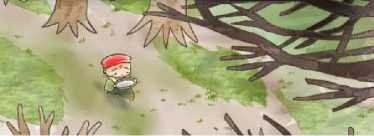
the Beauty of Withered Tree
The beauty of the sabi from Longhurst (2018: 61) is also seen when the cherry blossoms fall beautifully.
…おじいさんは村の枯れ木に灰をかけ、次々と花を咲かせていきました。
… Ojiisan wa mura no kareki ni hai wo kake, tsugi tsugi to hana wo sakasete ikimashita.
…The Grandfather took the ashes and scattered them on the withered trees in the village, and one by one the Cherry blossoms bloomed on the trees.’
Picture 4
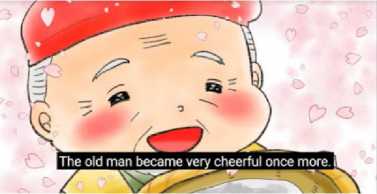
The beauty of Cherry blossoms
Blooming flowers (hana wo sakasete ikimashita) indicate sabi, in which time goes by or the existence of a life process that has passed. In this case the process refers to the process of the cherry blossoms blooming until the flowers fall to the ground beautifully, as shown in Figure 4.
Some of the principles of wabi sabi according to Suzuki (2020: 24-25) as seen from the Hanasaka Jiisan story include the grandfather's principles of living life in the following ways.
-
1) Living in tune with nature
The description of where grandfather lives in Figure 1 clearly shows that grandfather lives in a simple village. This simplicity can also be seen from Grandpa's quiet house and the Buddha statue beside Grandpa's house.
-
2) Averting from becoming frustrated by life's defects
There is no sadness for grandparents who do not have a child. When they see a confused dog, without thinking, Grandpa takes the initiative to treat the dog like his own child, and loves it.
子どもがいなかった二人は、「この子をわしらの子どもと思って、大事に育てよう。 」と言い、大変かわいがりました。
Kodomo ga inakatta futari wa, ‘kono ko wo washira no kodomo to omotte, daijini sodateyou’ ti ii, taihen kawaigarimashita.’
'The two elderly people who did not have children said affectionately, "Let's treat this dog like our own child." '
Picture 5

The Old man and his dog
-
3) Continuing to use old object but looking after them like old friends
The behavior of the grandfather who takes the mortal ashes shows that he treats the ashes like an old friend. The ashes are mortals made from trees that grow over his dog's grave. Eventhough it is no longer mortal, with a sad feeling, Grandpa still puts the mortal ashes in a container and brings them home.
…臼はすっかり灰になって いました。悲しみながらもその灰を持ち帰る…
… usu wa sukkari hai ni natte imashita. Kanashimi nagara mo sono hai wo mochi kaeru…
‘…the mortar has turned to ashes. The old man brought the ashes of the mortar home with a sad feeling…'.
Picture 6

The Old Man Saves the Mortar Ash
-
4) Taking things as what they are, accommodating fate's twists, and making the best of change in a life that is harmonious with everything around it
The sad grandfather turns happy when he learns that the mortar ashes he brings can turn a wilted tree into a flowering tree. He also sprinkles the ashes all over the withered trees in the village, so that the landlord who sees it feels the extraordinary beauty of the village and grants grandpa gifts.
…ふいに風が吹き、灰が枯れ木にかかったかと思うと、不思議なことにぱっと花が咲 きました。 「これは面白い。」おじいさんは村の枯れ木に灰をかけ、次々と花を咲か せていきました。
…Fui ni kaze wo fuki, hae ga kareki ni kakattaka to omouto, fushigi na kotoni patto hana ga sakimashita. ‘kore wa omoshiroi’ Ojiisan wa mura no kareki ni hai wo kake, tsugi tsugi to hana wo sakasete ikimashita.
‘… The wind blew, the ashes of the mortar clung to the dead tree, and miraculously flowers grew and bloomed on the tree. "This is interesting". The Grandpa took the ashes and scattered them on the dead trees in the village, and one by one the flowers bloomed on those trees.'
The Grandpa’s utterance 「これは面白い」kore wa omoshiroi ‘this is
interesting’, gives rise enthusiasm in grandpa's mind to turn his sadness into an interesting and meaningful situation, namely to make the village beautiful with many blooming cherry blossoms.
Picture 7
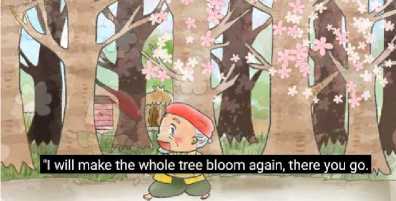
The Old man throws the ash to the Dead Trees
Hanasaka Jiisan fairy tale portrays the beauty of wabi sabi, which is a picture of the peaceful village where grandpa lives, the leaves falling when the dog dies, the trees wither, and the cherry blossoms fall. The wabi sabi principle carried out by grandfather results in enthusiasm for grandfather in living the twists and turns of his life.
Adek, M., Pangesti, N. R., & Asmawati. (2020). Wabi-Sabi and Aesthetic of Love in Lang Leav’s Love and Misadventure. Proceedings of the 3rd International Conference on Language, Literature, and Education (ICLLE 2020), January. https://doi.org/10.2991/assehr.k.201109.026
Devi, Rima, et.al. (2021). “The Reflection of Wabi Sabi in the Novel Joseito by Dazai Osamu”. Journal of Lingua Cultura, 15 (2), P. 167-173. DOI:
https://doi.org/10.21512/lc.v15i2.7004.
Garcia, Hector dan Francis Miralles. (2016). Ikigai: Rahasia Hidup Bahagia dan Panjang Umur Orang Jepang. Jakarta: Renebook.
Juniper, Andrew. (2003). Wabi Sabi: The Japanese Art of Impermanence. Tuttle
Publishing.
Kempton, Beth. (2018). Wabi Sabi: Japanese Wisdom For A Perfectly Imperfect life. London: Little, Brown Book Group.
Moleong, Lexy. (1997). Metode Kualitatif. Bandung: Remaja Rosda Karya.
Muthmainnah, Endah, et.al. (2021). “Konsep Keindahan Wabi Sabi Dalam Puisi Karya
Nakahara Chuuya”. Idea: Jurnal Studi Jepang, l3 (1). DOI:
Mori, Alicia. (2019). The Japanese Philosophy Of Accepting Imperfection And Taking Pleasure In The Transient Nature Of Earthly Things. Retrieved from https://b-ok.asia/book/7609956/1afa48[Accessed 21/10/2022.]
Suzuki, Nobuo. (2020). Wabi Sabi: The Wisdom in Imperfection. Spain: Dicoines Obelisco
Trevinarus, Jutta. (2010). The Value of Imperfection: the Wabi Sabi principle in Aesthetic and Learning. https://www.researchgate.net/publicaton/47437380.
Yurt, E., & Basarir, S. B. (2020). Aesthetics of Anaesthetics: Western Postmodern Attitude and Japanese Wabi-Sabi (侘寂). Kaygı. Uludağ Üniversitesi Fen-Edebiyat Fakültesi Felsefe Dergisi, September, 665–696.
https://doi.org/10.20981/kaygi.792651
Hanasaka
https://www.keishindo.co.jp/kawaiiwa/pdf/story_hanasaka.pdf
198
Discussion and feedback